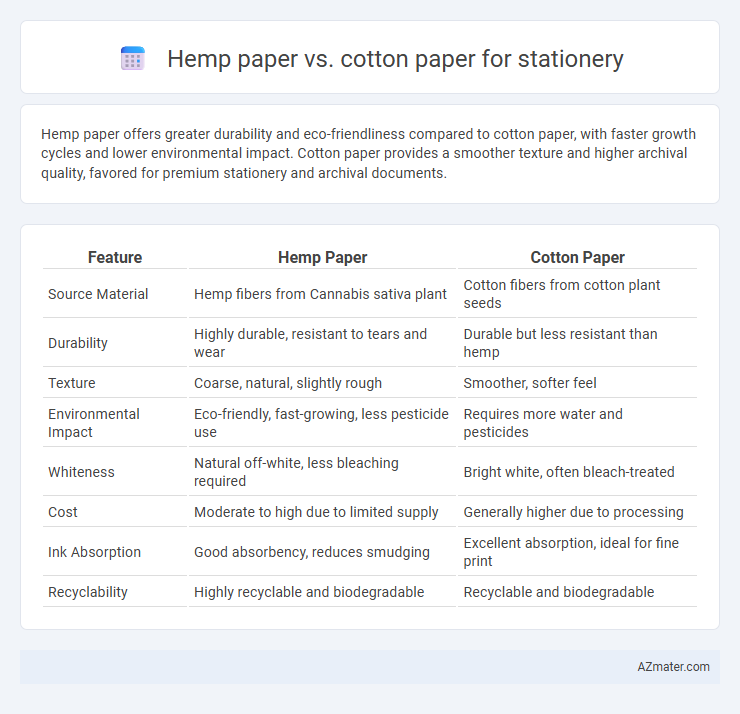Hemp paper offers greater durability and eco-friendliness compared to cotton paper, with faster growth cycles and lower environmental impact. Cotton paper provides a smoother texture and higher archival quality, favored for premium stationery and archival documents.
Table of Comparison
| Feature | Hemp Paper | Cotton Paper |
|---|---|---|
| Source Material | Hemp fibers from Cannabis sativa plant | Cotton fibers from cotton plant seeds |
| Durability | Highly durable, resistant to tears and wear | Durable but less resistant than hemp |
| Texture | Coarse, natural, slightly rough | Smoother, softer feel |
| Environmental Impact | Eco-friendly, fast-growing, less pesticide use | Requires more water and pesticides |
| Whiteness | Natural off-white, less bleaching required | Bright white, often bleach-treated |
| Cost | Moderate to high due to limited supply | Generally higher due to processing |
| Ink Absorption | Good absorbency, reduces smudging | Excellent absorption, ideal for fine print |
| Recyclability | Highly recyclable and biodegradable | Recyclable and biodegradable |
Introduction to Hemp and Cotton Paper
Hemp paper is made from the fibers of the Cannabis sativa plant, offering superior durability, sustainability, and resistance to yellowing compared to conventional papers. Cotton paper, derived from cotton linters or rags, provides a smooth texture and archival quality favored for premium stationery and official documents. Both papers serve distinct purposes in stationery, with hemp focusing on eco-friendly durability and cotton emphasizing softness and luxury.
Historical Background of Hemp and Cotton Paper
Hemp paper has roots dating back to ancient China around 105 AD, where it was first used for writing materials, while cotton paper emerged in the 19th century as a byproduct of the textile industry. Hemp fibers are longer and stronger, historically valued for durability in documents such as US currency and important archival materials. Cotton paper became popular for fine stationery due to its smooth texture and ability to hold ink, often favored in artistic and formal correspondence.
Environmental Impact: Hemp vs Cotton
Hemp paper has a significantly lower environmental impact compared to cotton paper due to its faster growth cycle and higher yield per acre, requiring less water and pesticides. Cotton cultivation is water-intensive and often relies on chemical fertilizers, contributing to soil degradation and pollution. Hemp's ability to regenerate soil nutrients and its biodegradability make it a more sustainable choice for eco-friendly stationery.
Production Process Comparison
Hemp paper production involves processing the bast fibers from the hemp plant through retting, decortication, and pulping, resulting in a durable and eco-friendly material with less chemical use compared to cotton paper. Cotton paper is made by harvesting cotton linters or recycled cotton fibers, which undergo pulping and bleaching, often requiring more intensive chemical treatments to achieve a smooth texture ideal for premium stationery. The hemp fiber's long strands contribute to higher tensile strength and quicker fiber breakdown times, making hemp paper production more sustainable and energy-efficient than the longer, more energy-intensive cotton fiber processing.
Durability and Longevity of Hemp and Cotton Paper
Hemp paper exhibits superior durability and longevity compared to cotton paper due to its longer fiber length and higher tensile strength, which makes it more resistant to tearing and wear. While cotton paper is also durable and often used for archival purposes, hemp's natural lignin content and resistance to degrading elements give it an edge in maintaining structural integrity over time. This makes hemp paper especially suitable for stationery intended to withstand frequent handling and extended use without yellowing or becoming brittle.
Texture and Appearance Differences
Hemp paper features a coarse, fibrous texture with a natural off-white color, providing a rustic and eco-friendly aesthetic ideal for artisanal stationery. Cotton paper offers a smoother, softer texture with a bright, crisp white appearance, favored for its luxurious feel and professional look. The durability of hemp contrasts with the refined finish of cotton, influencing the tactile experience and visual appeal for different stationery applications.
Cost and Market Availability
Hemp paper offers a sustainable alternative to cotton paper, often characterized by a higher upfront cost due to its processing requirements but holds long-term value through durability and eco-friendliness. Cotton paper remains widely available in stationery markets, benefiting from established supply chains and economies of scale that typically lower its price point compared to hemp. Market availability of hemp paper is growing, fueled by increasing demand for environmentally friendly products, yet it still lags behind cotton in mainstream stationery retail.
Sustainability and Eco-Friendliness
Hemp paper outperforms cotton paper in sustainability due to its rapid growth cycle, requiring less water and pesticides, and higher yield per acre, making it an eco-friendlier choice for stationery production. Hemp fibers create durable, biodegradable paper with a lower carbon footprint compared to conventional cotton paper, which often relies on resource-intensive cotton cultivation. Choosing hemp paper supports regenerative agriculture and reduces deforestation risks associated with cotton or wood-based papers.
Applications in Stationery and Printing
Hemp paper offers superior durability and environmental sustainability compared to cotton paper, making it ideal for eco-friendly notebooks, journals, and greeting cards. Cotton paper, known for its smooth texture and archival quality, is preferred for high-end stationery, invitations, and fine art prints. Both materials provide excellent ink absorption, but hemp's natural resistance to tearing and yellowing extends the lifespan of printed materials in everyday stationery use.
Choosing the Right Paper for Your Needs
Hemp paper offers superior durability and eco-friendliness compared to cotton paper, making it ideal for sustainable stationery choices. Cotton paper provides a smoother texture and higher archival quality, preferred for luxury or formal documents. Selecting between hemp and cotton paper depends on whether environmental impact or tactile quality is the priority for your stationery needs.

Infographic: Hemp paper vs Cotton paper for Stationery
 azmater.com
azmater.com